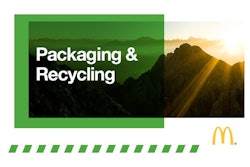
Packaging World:
Can you provide some background on AMERIPEN and the projects and initiatives it has been involved in since it was founded in 2011?
Kyla Fisher:
AMERIPEN was born in 2011 out of a U.S. Environmental Protection Agency recycling system financing workshop. Our founders walked out of that meeting with the understanding that there was a need for a unified, material-neutral voice for the packaging industry that would focus on data-driven solutions and reflect the needs and challenges facing all stakeholders across the packaging system. AMERIPEN’s emphasis is on the intersection of packaging and policy.
Our initial publications were focused on the recycling system and the best ways to drive system efficiencies. The 100 Cities Packaging Recovery research report released in 2013 identified the value of cart-based systems as a best practice. Our financial platforms report looked at global packaging recovery policies to identify best practices for financing and driving efficiencies across the recycling system. We still use that data today in many of our conversations with states where we note how Pay-as-You-Throw [PAYT] programs, universal access to recycling and landfills bans with a plan can drive increased packaging recovery in a cost-effective manner.
Our work is much broader than resource recovery and recycling however. We’ve spent considerable time trying to understand the role Sustainable Materials Management [SMM] and Circular Economy [CE] thinking can play in packaging design and policy. We continue to explore the impact of e-commerce on packaging systems as well as the value of packaging in reducing food waste.
When you released your series of brochures on the value of packaging, who was the intended audience?
Andy Hackman:
Our targeted audience will always be policymakers. While we recognize that the general public could benefit from a value-of-packaging message, we believe our most effective outreach is directly with policymakers. For example, right now as policymakers are seeking to meet the national goal of 50% reduction in food waste, our brochures, which identify ways packaging can reduce loss, help inform that discussion. Our efforts are focused on reducing unintended consequences, and part of that will come from understanding the value of packaging.
In 2017, both Connecticut and California considered Extended Producer Responsibility for packaging. While neither have passed legislation yet, do you see this as a viable option, and is interest in EPR for packaging growing again?
Hackman:
In 2017, California and Connecticut were the most active states on the issue of EPR and packaging. While both expressed interest in EPR for packaging, they are still trying to grapple with how that might be implemented. Both states are driven by extremely aggressive recycling and recovery goals. In many circumstances, when you do the calculations, their proposed strategies for reaching those goals are not likely to be achievable. For example, we tend to set recycling goals based on tonnage collected, but this ignores the lightweighting we’re seeing—which is generally a positive environmental design factor. When you take into account how material optimization has led to lightweighting of the recycling stream, in most cases the recycling rate increases. Tonnage-based goals also ignore the opportunity to focus on the materials with the greatest environmental impact.
Fisher:
To Andy’s point, Dr. Tim Townsend, a professor from the University of Florida, recently did an analysis of Florida’s 75% recycling goal. He noted that once you account for lightweighting, the state’s recycling rate increases. He also noted that to reach the 75% recycling goal, more attention needs to be focused on materials such as food waste and construction and demolition debris, and less on packaging. If we extract his findings to Connecticut and California, we see they’ve placed an emphasis on packaging, but in doing so, overlook some of Dr. Townsend’s other findings, thus missing some significant opportunities to identify existing successes as well as find low-hanging fruit. Recognizing that each state will be different, we’ll be doing some further analysis with Dr. Townsend over 2018 and look forward to sharing those findings.
Hackman:
The risk of implementing a policy without understanding the full picture will result in unintended consequences, and that’s what we try to discuss with these and other states. When you look at it this way, we believe EPR is not an effective tool for recycling system change; a number of studies show it’s not a mechanism that will create efficiencies. Yes, an injection of money would be nice, but that still doesn’t solve the systemic challenges. The solution to increasing recycling and reducing environmental impact is much more comprehensive than implementing EPR or financing the system. Shifting consumer behavior, packaging optimization, issues of quality, collection and processing, and end markets are all influencing factors. We need holistic policies to help address each of this phases as an integrated whole.
Our objective is to help advance the dialogue beyond one simple policy approach. While EPR may be on the radar of a few states, we don’t believe it’s gaining the momentum it had back in 2012. We feel the dialogue has advanced beyond system financing toward a broader understanding of systemic change and how best to achieve that, and most of the states and organizations we speak to understand we need a toolbox approach.
Fisher:
Along those lines, another notable study, done by York University in Toronto, looked at why The Blue Box Program costs have increased more than 70% since EPR came into law. The study identified that while the program enables increased material collection, much of that material ends up in the landfill because the quality is poor or there are limited end markets for the material, for example, multilayer films. Increasing recovery does not mean taking all materials; we need to ensure processors and end market are available and cost effective. All of this needs to be considered when examining the best ways to recycle packaging and measure recovery rates.
China’s announcement on restrictions on imports of solid waste materials into the country has threatened many domestic markets. Some argue this provides an opportunity to revitalize markets here in North America. What impacts do you see this having on domestic markets and packaging policy?
Hackman:
Changes in China’s import policies are having a significant impact on recycling globally. On January 1, 2018 China banned 24 materials, including Unsorted Mixed Paper and Mixed Plastics. On March 1, 2018, an additional policy restricting prohibitives to less than 0.5% will officially go into effect. Considering the average U.S. processor produces bales with 2% to 4% contamination, this has caused much concern across the industry and shifts some of the discussion on packaging recovery toward material collection—quality versus quantity.
As a result of the Chinese Sword, some municipalities may not have a marketplace to sell some of their materials. From a policy perspective, this may help drive support for domestic reprocessors and end markets as well as reinforce a discussion on goal setting with a shift away from quantity towards quality. This could be a positive discussion to permit more systems thinking at the policy level.
It is putting a lot of pressure on West Coast states like California, Oregon, and Washington, which were exporting much of their recycled material to China. This could have ramifications for California’s interest in EPR and will certainly drive interest in places like Oregon where they are focusing recycling investments into targeted materials based upon environmental impact and where infrastructure is most needed.
Overall, we expect the discussion in 2018 to focus on the quality of material collected and how to spur investment in domestic recycling and reprocessing capacity. This will require looking at system efficiencies, not just at financing.
Recently, some states and recycling agencies have called for new metrics to measure recovery. Can you explain why this is happening and what impact it might have on packaging and recovery policies?
Fisher:
I believe this will be a key trend for 2018. There is a gradual shift occurring around packaging recovery toward a discussion around impacts versus outcome. A number of different groups are pushing a discussion around more holistic metrics. As we noted earlier, tonnage doesn’t provide enough insight; we need to understand access rates, contamination rates, material environmental impacts, etc. From a design standpoint, packaging optimization efforts are shifting recycling impacts. This currently is unaccounted for. We need a more holistic picture of recycling and solid waste in order to define success.
The City of Seattle hosted a one-day workshop in November 2017 on this specific topic to gather insights from a wide range of national stakeholders as they seek to revise their solid waste programs. The Southeast Recycling Development Council [SERDC] and the U.S. EPA are hosting another conference, the Measurement Matters Summit, in February 2018 to discuss best practices in reporting, and organizations such as AMERIPEN and The Recycling Partnership have been promoting new metrics and systems thinking for a few years now. Stakeholders are realizing that recycling success requires so much more than simple volume—the discussion is shifting from outcome to impact. This is positive.
In 2016, the SPC and The Recycling Partnership both released reports discussing the domestic access rate to recycling. Has this data shifted some of the packaging recovery policies you’re seeing across the states?
Hackman:
That analysis caused some pause by the states, but we’re not seeing it translate into policy just yet. Increasing access has been a key focus of AMERIPEN, and we will continue to promote the value of universal and automated access. The original SPC Access to Recycling report noted that 50% of Americans have easy access to recycling. That means for half our population, recycling is inconvenient. When we look at policies to increase recycling we often ignore the role of the consumer, but aspects like access and ease are instrumental in generating engagement in recycling. Carts are an effective example of a program designed to make recycling easier for the consumer. Recently some cities have focused on automatically enrolling residents in curbside programs, rather than using opt-in subscriptions, or providing access to multi-resident homes, or apartments—this is another key strategy. Connecticut was the first state to harmonize recycling materials among all Materials Recovery Facilities, this may not be possible in all states due to the vast differences in infrastructure and size, but where possible, this helps simplify messaging to the consumer so they understand what goes in the carts. We can’t forget that the consumer has a significant role to play in recycling, and policies that can help simplify their engagement have proven effective.
AMERIPEN released a paper in 2017 looking at the potential impact e-commerce might have on packaging policies. Can you highlight some of the key concerns you identified and what’s being done to address them?
Fisher:
The first instance where we saw e-commerce linked to packaging policy was in Connecticut. We wanted to understand what, if any, impact e-commerce would have on the packaging system. E-commerce has grown so rapidly, it’s hard for anyone to keep up and anticipate the changes. We wanted to offer proactive solutions rather than wait to respond to policy reactively.
What we found was that e-commerce and omni-commerce are creating an entirely new delivery system that shifts not only how we design our packaging, but also our recovery system. New materials and new forms of collection will shift how well the recycling system works. For example, one of the most sought-after materials is corrugated cardboard. In traditional retail, cardboard would be collected and sorted at the retail level, and MRFs and processors would receive clean, uncontaminated bales. Now, with a shift from retail to household, this same material is being collected in residential recycling containers, so the risk of contamination increases because it’s collected with more materials. In addition, larger carts and collection vehicles for this material may be needed. Planning ahead helps us offer proactive solutions to our state partners.
Additional issues around e-commerce packaging include the role of end markets and the role of packaging in food safety—for example, how can we protect meat in meal kits left outside for eight hours? What about worker safety for delivering these options? We’re now shipping larger items, liquids, food, and other products in a different way, but there has been no change in labor standards. We need more data to understand this and other impacts. This will be focus of one of our member workstreams in 2018.
Besides packaging recovery, is AMERIPEN tracking other policy/regulatory issues?
Hackman:
To date, the majority of bills we’ve seen and acted upon have been about packaging recovery, but we have also worked in coalitions with many peer associations to support efforts around marine debris, littering, and reform of The Toxic Substances Control Act, among other issues.
Fisher:
AMERIPEN is charged with addressing any policy related to packaging and the environment. One additional area we’re engaged in is the Sustainable Accounting Standards Board [SASB]. This is a voluntary standard that seeks to define sustainability metrics for all public U.S. industries to report on when they file their annual reports with the U.S. Securities and Exchange Commission. From a packaging standpoint, we’re concerned about the attempt to standardize metrics for “packaging” as a whole. Different materials have different impacts and different processing technologies, which makes it hard to create metrics that enable an-apples-to-apples comparison. Working collectively, we’ve led an industry response to SASB.
We also continue to evaluate the role of packaging in reducing food waste. In January 2017, we released a new report examining this topic and identifying new areas of research needed to identify best practices. We caution that policymakers looking at this issue must integrate their approach. When a policy targets packaging reductions, it might inadvertently increase food waste. Key going into 2018 will be examining how we can integrate food waste and packaging policy to achieve overall environmental and social benefits.
What do you predict will be the key states and policies relevant to the packaging industry for 2018?
Hackman:
Things to watch for in 2018 include EPR discussions in California and Connecticut; solid waste planning discussions in many states, including Michigan, Oregon, and others; solid waste infrastructure planning and funding in West Coast and East Coast states; product and package bans in a few states like California; and bottle bill reform discussions in New England and California.
The Circular Economy appears to be gaining momentum, especially in Europe. Will this come to the U.S., and what impact do you think this will have on packaging policies here?
Fisher:
The Circular Economy is a concept whereby we continue to reuse materials and reduce virgin use; many people refer to it as a closed loop. CE has the public’s attention because it’s easy to understand and measure. Sustainable Materials Management is life-cycle thinking. The idea is that waste is produced all along the life cycle of a product, not just at end of life, so one should focus on reducing the greatest amount of waste wherever it occurs. Ideally you could tackle all impacts, but with limited resources, careful analysis helps inform the best approach.
We believe both of these frameworks will gain momentum. It shouldn’t be an either/or proposition, but rather we should look at how they can complement one another. In 2016, AMERIPEN published a white paper looking at these two sustainability frameworks in the context of packaging. That paper includes a case study that analyzes a popular packaging policy: the use of recycled-content mandates. This is a great example of CE thinking, but when applied to paper, we noted unintended consequences. Paper recycling occurs on a hierarchy—the more refined the paper, for example magazine or office paper versus paperboard or corrugated, the greater the environmental impact when using recycled content. Magazine and office papers require more bleaching and pressing. Thus, mandates for office paper and magazine print may actually be resulting in increased environmental impacts rather than their intended purposes of decreasing impact. This deeper dive, looking at where mandates make sense, exemplifies SMM thinking.
One of the reasons we invested so much time in understanding these two frameworks is that people and states latch onto concepts. With CE in the popular media, we need to ensure we’re still evaluating for unintended consequences and looking for the best environmental outcome. We believe these frameworks can be effective when they work together to help identify opportunity as well as risk.






















